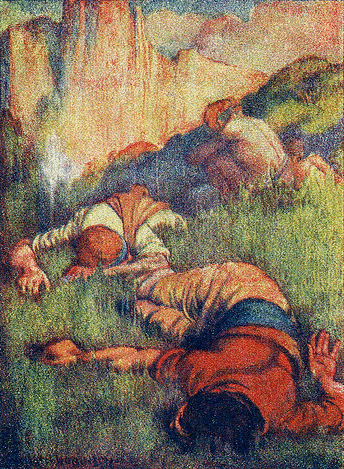Sean Kullman is the Director of the Global Initiative for Boys and Men and Substack author of In His Words. He is also a cogent analyst of all things male. Today we feature his guest blog post on the despair of boys and men, and what should be done about it culture-wide.
Sean will be a keynote speaker at our Summer Training Institute in June. To hear Sean speak, to learn more about the Summer Training Institute, and to register, please visit: https://gurianinstitute.com/
Let’s open our hearts and minds to boys and men

Odysseus men on the island of the lotus eaters by W. Heath Robinson
Earlier this year, I addressed the shift in the way mental health was treated, going back as far as the discovery of Thorazine and Stelazine in the 1950s. The discovery of these drugs facilitated a belief in the 1960s that medication, halfway-houses, and community-based support was a more humane and better approach than the collaboration of mental health institutions, half-way houses, and the use of medication. Large mental health institutions were going to become a thing of the past, and the public seemed to agree, as state after state started closing large mental health institutions and saw a steady rise in homelessness and addiction.
There is no denying that medications have played a significant role in improving the lives of people with things like diabetes, cancer, heart disease, pain, and other physical and mental health problems. But somewhere along the way, the U.S. lost sight of the fallout of the overemphasis on medication and the lack of other essential services and cultural shifts that only exacerbated the mental and physical health crisis that has disproportionately impacted men.
In an article (American men are dying younger) by Richard Reeves (President of the American Institute for Boys and Men and Non-Resident Senior Fellow at the Brookings Institute), Reeves discussed life expectancy, suicide, and COVID as prime examples of the way policy has shifted over the past several decades and has left men out in the cold.
Reeves writes:
I don’t think this is because the officials at HHS don’t care about boys and men. I think it is because there are no official agencies in government with a specific focus on the health of boys and men, advocating on their behalf.
The proposal for an Office of Men’s Health is not new. The idea has been around for some time. But given recent trends, it sure seems like an idea whose time has come.
And, Reeves is on to something. In a number of education meetings (at the state and federal level) with policy makers, they are always staggered when I pull up the data on the deaths of despair (suicide, overdose, and alcohol) and learn that the disparities are so troubling for boys and men, regardless of race.
In a report being prepared by the Global Initiative for Boys and Men and the American Institute for Responsible Research (AIRR), numbers show that males are the ones most likely to suffer from deaths of despair, and this cuts across all racial groups.¹
Understanding Despair
On the same day Reeves released his piece, MSNBC’s Joe Scarborough interviewed actor Courtney B. Vance, who lost his father and godson to suicide and who released a new book, The Invisible Ache: Black Men Identifying Their Pain and Reclaiming Their Power with co-author Dr. Robin L. Smith.
Although Vance focused on suicide in the black community, his message clearly speaks to all people and was expanded by Scarborough, who made a point of rephrasing a more general message about men from the book’s co-author Dr Robin Smith: “don’t hide your grief, which is something we men are not particularly good at of whatever race.”
In an attempt to understand the suicide deaths that disproportionately impacts males, it’s equally important to discuss overdose and alcohol deaths because the root cause of these outcomes is despair. Although there may be a slight dip in any particular year in the number of suicide deaths, for instance, there is likely to be an increase in the other diseases of despair.
The creation of an Office of Men’s Health is long overdue and is not the only area where male outcomes need a cultural awakening. The challenges facing boys and men happen, in great part, because there is minimal collection of data (except by those deeply involved in this issue), too few agencies specifically and robustly concerned about male well-being, and a general malaise in the habitual and selective way media, academic, and government cover issues pertaining to boys and men.
Attention to boys and men tends to be intermittent and rare instead of consistent and true, even as one singular truth exists: Boys and men of all races are more likely than their female counterparts to die younger and die of despair.
There are some policy makers who are beginning to take notice at the state and federal level and these policy makers are the ones who have taken the time to objectively look at male outcomes and acknowledge the neglect. No state or federal agency can allocate its resources effectively and impactfully without the data supplied by a small handful of groups who are privately working on the areas impacting boys and men. And those policy makers who have opened their hearts and minds to this issue are often beleaguered by opposing forces struggling to reconcile this truth with themselves and the demands of their constituencies, even as the United States has seen over 570,000 boys and men die from overdose, suicide, and alcohol causes from 2018-2022.
- Numbers in the graphs and tables above may be slightly different than the current numbers listed by the CDC as the agency continues to update its 2022 provisional data. AIRR is in the process of updating these tables. However, there is no meaningful statistical difference in outcomes.















